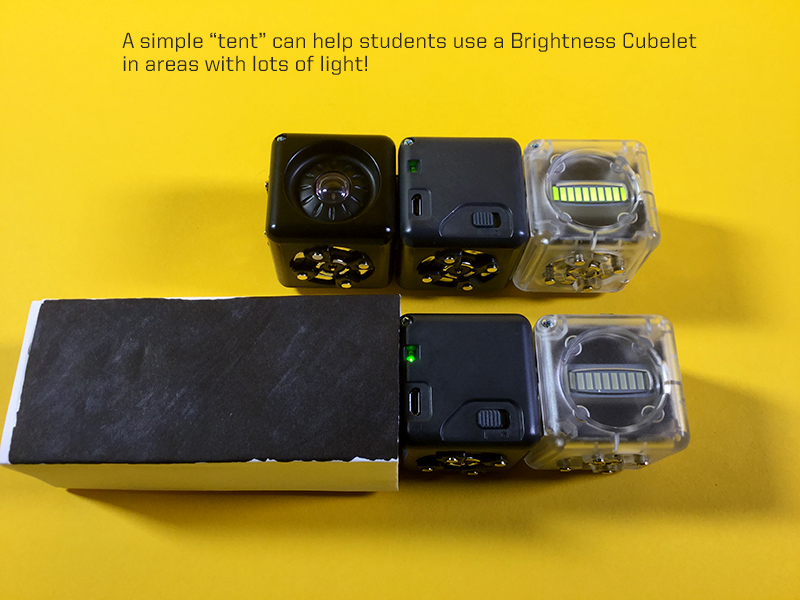A.M.4. | Data Collecting

Created by: Modular Robotics
Lesson Overview:
Students will now practice recording their data and discover the importance of data collection. They will continue to build knowledge about how complex systems are made up of smaller parts.
If you feel that your class already has a handle on data collection from other science units then you can skip this lesson.
If students need more review in building the robots and understanding the concepts introduced thus far, or need more practice in data collection, then use this lesson as a review for some, or all, of your students.
The Basics:
Ages: 10 – 12 years (grades 4-6)Time: 30-45 minutes
Prep Time: 5 minutes
Lesson Goal (for the educator): To have students become more precise in observing, testing, recording, and analyzing data
Lesson Objectives (for the students): I will be able to collect and record data to more precisely analyze input effects on output behavior.
Essential Questions: Why is precise data collection so important?
21st Century Skills: Creativity and Innovation, Critical Thinking and Problem Solving, Communication and Collaboration
Concepts: Data collecting
Vocabulary: Precise, precision
Required Cubelets: Distance, 2 Drive, Battery, Brightness, Rotate, Flashlight, Rotate, Passive, Inverse, Blocker – enough for each group of 2-5 students
Additional Materials: Student Robotics Journals, flashlights, tents (refer to the Educator Information Sheet)
The Standards:
ISTE: International Society for Technology EducationCCSS: Common Core Standards
NGSS: Next Generation Science Standards
- NGSS Grades 4 and 5 3-5-ETS1-1, 1-2, 1-3
- NGSS Grade 6 MS-ETS1-1,1-2, 1-3
Prior Knowledge Necessary for the Student:
Prior Knowledge Necessary:- Building different configurations of robots that react to sense
- If no prior knowledge: Lesson A.M.3
Prior Knowledge for the Educator:
- Precise data collection is essential in scientific studies, but let the students discover this on their own.
- Don’t tell the students how to record their data – allow them to work as a team to discover what works for them. If you have a certain protocol for data collection you will be able to teach them about this later in the lesson.
Preparation:
- Divide the class into groups of 2-5 students
- For each group, place in a container the Cubelets they will need along with a flashlight and a tent (see Educator Information Sheet for tent information).

Lesson Plan Assets and Resources:
Click the buttons to download the Robot Journal and Extra Journal Pages:
Click the button to download the optional A.1.WS PDF:
Click the button to download the Appendix A.M.4 PDF – What I know about data collecting:
Lesson:
Introduction:
-
Time: 3-5 Minutes
- “Thus far, what have you learned from your investigations building these robots?”
- Allow the students to respond.
- “What did you discover was confusing about all this data you have been collecting? What has made it difficult to make conclusions?”
- Allow the students to respond. See if you can get them to realize that this is a lot of information to keep track of in their heads and then talk about ways that scientists collect and analyze data and the importance of keeping good records.
- Review the Objective and the Vocabulary Words
- “This time, as you build and test robots, let’s see if your team can come up with some good strategies for keeping track of all of your data. See what you can find out about the different functions of the Cubelets and what makes a robot work successfully.”
- For students who may need a more concrete way of recording their data use the worksheet: A.1.WS
Time To Explore:
Time: 15-20 Minutes- Allow the students to explore and work together building and testing robots. Be sure they are working collaboratively to come up with ways to collect and record data.
- To facilitate this, walk around the room asking questions:
- Has your team come up with a way to collect your data?
- How might you be more systematic in your approach?
- If their data collecting method doesn’t seem adequate encourage them to think about more precise methods. Time: 3-5 Minutes
- Stop the class and ask some of the groups to share what they have discovered about collecting data. If you have an Opaque Projector you could show their work this way.
- Point out some of the stellar examples of collecting data and encourage the students to modify their methods in ways that you see fit according to your own, or your school’s philosophies/methods for this task. Time: 5-10 Minutes
- Allow the students more time to explore with their new knowledge Time: 5-7 Minutes
- Stop the class again and give them time to record their observations and conclusions in their Robotics Journal. Encourage them to use words and other methods of recording such as charts, sketches, flow charts, etc.
Closure/Evaluation
-
Time: 2-3 Minutes
- Recap with the students what they learned in this lesson. Review the vocabulary words and highlight the importance of data collection. Time: 2 Minutes
- Allow time for students to put materials away and plug in the Battery Cubelets for recharging.
End Results:
Students will discover ways to collect data in a precise and accurate way, while continuing to learn more about the functions of the Cubelets.Optional Quick Write For Prompt and/or Evaluation
Have students fill out the What I Know About Data Collecting evaluation sheet (Appendix A.M.4 Data Evaluation).
Educator Evaluation of Students
What to go to Next:- Repeat this lesson – Data Collecting A.M.4 or a lesson of your own on data collecting
- Sensing and Magnitude A.M.5 or Build More Robots A.M.4.5
- Extend the challenge with Build More Robots A.M.4.5
This work is licensed under a Creative Commons Attribution-ShareAlike 4.0 International License.


